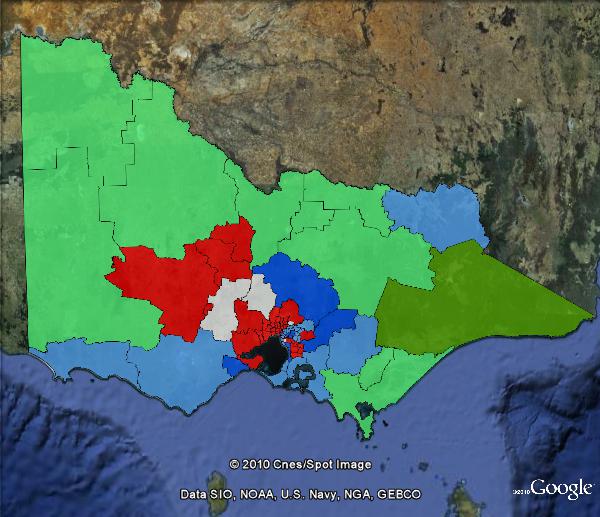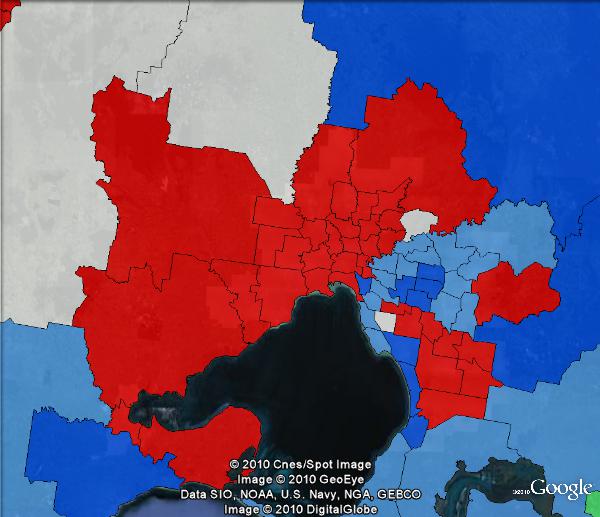Clearly last night was a terrible result for the ALP. Until the last few weeks Brumby seemed on track for comfortable re-election, and it was only the final pre-election polls that predicted a Coalition victory. It also suggests any Labor government is in trouble. No-one has expected the NSW Labor government to be able to win re-election in next March’s election, but last night’s result suggests the ALP’s problem is much deeper and broader than just NSW Labor.
There was a lot of talk about a ‘hung parliament’ last night, much of which seemed to be desperate hope from the ALP. However it’s important to point out that this is not like any other recent hung parliament, like those currently operating in the federal Parliament and in Western Australia, Tasmania, the ACT and the Northern Territory. In all of those jurisdictions (and other recent hung parliaments in Victoria, New South Wales, Queensland and South Australia) there were independents or Greens in a balance of power position who had the capacity to form an alliance with one party and give them a majority, however unstable it could be.
Yet we are talking about a tied parliament, not a hung parliament. The Victorian Legislative Assembly has an even number of seats, and after Craig Ingram’s defeat and the failure of the Greens to win any Assembly seats, there are no crossbenchers at all. This is the only parliamentary jurisdiction in Australia to elect a chamber solely consisting of major party MPs, despite the trend towards more independents and Greens around the country.
I don’t see how a tied parliament allows either side to govern. While the ALP remains in government until they are removed, I cannot see how the Assembly could even elect a Speaker, and it would quickly become dysfunctional. The only way for any stability in this Parliament would come if a single MP was enticed to switch sides and support the other side, or possibly accept nomination from the other side for Speaker. Apart from that, the only solution would be to head back to the polls for another election.
So what is the likelihood we will see a tied parliament?
At the moment it seems that the Coalition has won at least 44 seats. There is no prospect of a Labor majority. There is currently one seat where the Coalition is leading by a slim margin – Bentleigh in southeastern Melbourne. According to the VEC, the Liberals lead in Bentleigh by 213 votes. In addition, there are a number of other seats where Labor’s lead is not solid. The ALP needs to win every one of these seats. The exact list of seats in the “undecided” column varies – it definitely includes Macedon, but has also included Eltham, Ballarat East, Albert Park and Narre Warren North. William Bowe at Poll Bludger is following the count in these photo finish seats.
Labor’s losses also tell a clear story. The ALP lost the first nine Labor vs Liberal seats on the pendulum, with margins up to 3.7%. They have also lost Carrum and Seymour, both of which were held with 6.7% margin. They are trailing in Bentleigh (6.3%) and slightly leading in Macedon (8.2%). Yet they held on in regional seats like Ripon, Bendigo East, Ballarat West, Ballarat East and Monbulk, all held with margins of 4-7%. Labor lost three seats in regional areas on the fringe of the metropolitan area (South Barwon, Gembrook, Seymour). They lost another eight seats on the south side of the Yarra, stretching from Prahran down to Frankston.
The result was clearly a disappointment for the Greens, but this should be kept in perspective. I don’t believe it was a disastrous result, even though it wasn’t what people were hoping for. The Greens didn’t manage to win any extra Legislative Council seats or any Legislative Assembly seats, and the increase in the Greens vote was very slim, and much less than in the federal election or what the recent polls have been projecting. On the other hand, this has not been a collapse for the Greens. In Western Metropolitan there has been an increase in the Greens vote but sitting MLC Colleen Hartland is in a very close contest with a Labor candidate to see if she can hold on. In Southern and Northern Metro the Greens have retained their seats.
In the Legislative Assembly the Greens vote increased in Melbourne and Richmond while the ALP suffered big swings against them. In Brunswick the Greens suffered a slight swing against them, but the ALP suffered much worse with Cleary picking up a lot of that vote. In all three of those seats the Greens improved their position before Liberal preferences are factored in, but lost all three seats because of the Liberal preferencing decision. Make no mistake about it – that has hurt the Greens. But they still maintained their vote and ran a strong campaign. I think there’s some parallels here to the 1998 Tasmanian election, when the major parties cut the size of the Parliament in order to lock out the Greens – and almost succeeded. Twelve years later the Greens have more seats and a much higher vote. More significantly, they are a solid presence who can’t be locked out by the major parties.
In Victoria the Greens still got a record vote. Liberal preferences may have defeated Greens in Melbourne, Richmond, Brunswick and possibly Western Metro, but the Greens have moved closer to the day that they can win those seats without Liberal preferences. It is probable that the Liberals will repeat this preferencing decision in the future. While it may have been strategically stupid to help out the ALP in those seats, it didn’t hurt the Coalition this time. If they had fallen one seat short they may have been regretting this decision, but with such a brilliant result for the Liberals we’re sure to see people argue that putting the Greens last helped the Liberals win. Even still, it is not a certain outcome, and despite the increased Labor margins in their seat the sitting Labor MPs still face the prospect of Greens winning the seats in the future.
For the Greens, this is the equivalent of an election result for a major party where they fail to win government, but without really going backwards. The Greens stalled at this election, but they haven’t collapsed. More people voted Green than ever have before in a Victorian state election. It’s important to keep that in perspective.
Let’s look at the Legislative Council. The Coalition has won at least 19 seats. The ALP has won 16 seats, and the Greens have won at least two. There are three seats still in play. In Northern Victoria the Country Alliance is leading over the Liberal Party (1452 votes according to Antony Green’s calculator). As I mentioned earlier, the Greens are trailing by 2032 votes behind the ALP. In that race Liberal preferences currently are favouring the ALP.
The other race that has emerged this morning is in Northern Metropolitan. The ALP has won two seats, the Greens one and the Liberals at least one. The final seat is currently going to independent Stephen Mayne, who has polled barely 1% of the primary vote. Mayne jumps ahead with Greens surplus, then with preferences from Family First, the DLP and the Sex Party. At this point Mayne overtakes Labor and Liberal, and defeats the Liberal on Labor preferences.
Finally, here are some maps showing results in the Legislative Assembly. Seats that have not changed are shown in red for Labor, light blue for Liberal, light green for Nationals. Liberal gains are in dark blue and the sole National gain is in dark green. Four undecided seats (all previously Labor-held) are shown in white.





Just a comment:
If the coalition ends up on 44 seats, this is definitely going to hurt the coalition. A result of 44 Coalition, 41 Labor and 3 Green, may have been quite different for the coalition than 44 each.
And of course, if the Coalition got 45, the Greens would make no difference, and at 43, at least they’ve got the chance to block legislation with the help of the Greens (for example, on the Federal level, the ETS).
Which ever way I look at this, I really can’t see the logic in the Coalition’s decision. Why you’d want all three potential lower house parties preferencing towards your opponents I just can’t understand. They’re lucky it hasn’t resulted in a majority Labor government. In addition, whilst it might be ok, it may cost them the chance to form a government of their own.
I don’t see it as such as big deal since the Greens almost always favour Labor in such scenarios anyway. Look at the federal election, Adam Bandt basically declared from the outset that he’d support Labor no matter what.
Yes, a potential 44-44 would be one instance where the Greens could be forced to support the Liberals, but the odds of that happening would be rated pretty unlikely before the election. In any other ‘hung parliament’ situation the Greens would have sided with Labor, almost certainly. Plus you can argue very strongly that being seen as “anti-Green” helped the Liberals enormously in the outer suburban seats where they did so well. Doing a deal with the Greens might have meant the Libs wouldn’t even be within one seat of victory.
We will never know but I think the whole Greens preferences debate distracted voters from focusing on the government’s flaws and the viability of the Colaition’s alternative. Once it was out of the way the Liberals surged. On the Greens Labor was able to hold the line in the inner city maybe at the cost of losing ground elsewhere. Labor cant be written off.
Good analysis Ben but the Greens need to seriously look at what happened in the inner Melbourne electorates and figure out why the vote did not go up by more than it did. To me it seemed like excellent conditions for the Greens in Victoria to do perhaps better than what they did at the Federal election. NSW needs to study this because a similar situation may occur in March.
Was it simply, “Oh well the Libs aren’t preferencing the Greens, therefore the Greens can’t win, so why vote Green”? If so, there needs to be a strategy developed to deal with it because we all know the Liberals will probably never preference the Greens again.
A semantic point, I would argue that a tied parliment is a special case of a hung parliment, since the definition of a hung parlliment is a parliment where no side has an absolute majority, and in a tied parliment no side has an absolute majority.
i.e. :
http://news.bbc.co.uk/2/hi/uk_news/politics/8427233.stm
If the result is 45 – 43, I’d expect Labour to treat the pairing issue exactly the same as the federal Liberal party.
Comments are closed.